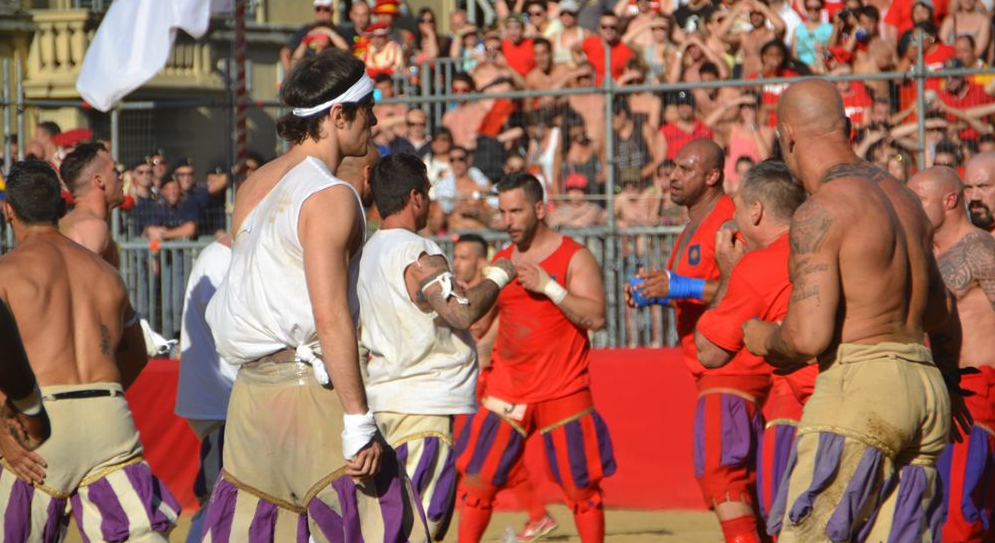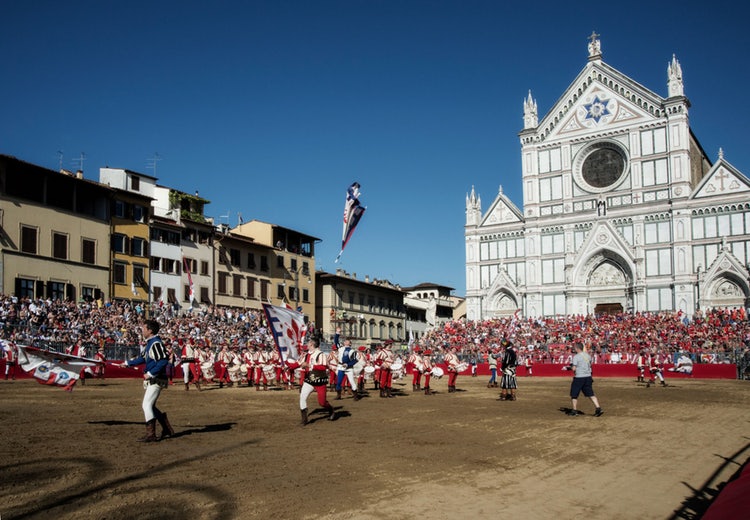Bruised, bloodied and battered, the Bianchi (white) team celebrated a Calcio Storico victory in the final held in Piazza Santa Croce in Florence last Saturday. Those men who were victorious – more like gladiators than competitors – hail from the Santo Spirito area of the city, and brought about a close victory over the Rossi (reds) from Santa Maria Novella. (For a more detailed explanation of this unique event, you can read more here)
Part of that winning side was Englishman James Zikic, who has been present for three consecutive Bianchi victories, but will be unable to compete from next year, due to a tightening of the rules. Teams are currently allowed two non-Florentines, but in an attempt to preserve authenticity, authorities have decided that everyone who plays from next year must be native to the Renaissance city.
Rarely giving interviews to those deemed outsiders, two members of that winning side have spoken exclusively to The Gentleman Ultra, explaining what this incredible spectacle signifies for Florence.
“First of all, it’s a game, not a sport,” Calciante (competitor) Peggion Giacomo declared. “It means a lot for the city, it adds to it specialness and uniqueness and makes Florence even more desirable. Winning the game will mean the end of a tough journey that started right after last year’s tournament. It will mean glory and happiness for the winning team.”
“We choose to play this game for the same reasons a man climbs the highest mountains and sails the most tempestuous seas. Mankind wants to challenge and test itself and everybody does it in the way he prefers and the way that feels more natural to him.”
What is more important to the players, the historical aspect or the game itself?
“I think both of the parts are fundamental,” Peggion continued. “I love my city and playing Calcio Storico is a way to be even more in harmony with it. It’s like if you would meet the woman you love carrying some heavy items. You would carry those heavy things just to feel closer to her, more in contact. So I keep the Florentine traditions alive to feel even more part of the city. I want to help her to last a long time.”
The medieval Flag Throwers provide the usual pageantry in front of the Santa Croce ahead of the main event.
“As well I love the extreme nature of the game, I’m so close to my teammates. I don’t know if I would play it If there wasn’t the traditional and historical component. There are a lot of “extreme” sports around… this is not a sport and it’s unique.”
Another Calciante – Lorenzo Taddeucci – then revealed how he got started playing Calcio Storico.
“I started in 2013 but my first year was just training, he said. “I was not good enough to play. I had to wait one year, then I made my debut in 2014. I have played the last three years and the Bianchi has won every game.
Why have you opted for the Bianchi in particular?
“I chose Bianchi Santo Spirito because it’s my neighbourhood, it’s a natural choice. When you grow up there with your friends, you want to play for the local team with them. Bianchi are like Ferrari in Formula One, everyone wants to drive one. I think it’s the same with Calcio Storico, everyone wants to play for the white team.”
Many Florentine families who had historically lived in the centre have now been priced out of their areas, as soaring property values has seen rich foreigners invest in the highly-sought after central parts of the city. Lorenzo explains how this makes playing for the Bianchi more desireable to the locals.
“The Santo Spirito area is the last real Florentine neighbourhood, so there is more connection with the team,” he says. “A lot of my team-mates live and work in the neighbourhood so it gives us the “extra factor”. The white team is one of the best ever, and it’s all of these things together that makes people want to play for them – but there’s only 27 players so if you want to play you have to be in shape. I’m lucky to play for the Bianchi, we are like a family so it’s a natural thing for me.”
The Bianchi celebrating their victory over the Rossi in Saturday’s final
What makes this game so special for the city?“It’s about pride, you know, it’s about glory. You play for your city first of all, every time you step into the arena it’s for the pride and the glory of your city. There is no money involved, so it’s just for honour and pride. Everyone recognises that, so that’s why this kind of game is so special for the Florentine people.”
The incredible atmosphere inside the arena – enclosed on four sides by temporary stands in the piazza – is attracting increasing number of foreign spectators every year. But what is it like for those inside it?
(Laughs) “Yeah, I can’t really begin to describe it, it’s something amazing. Everyone has their own feelings, it depends on the person, but for me it’s the best feeling ever – truly. You cannot have these kind of emotions in normal life. It’s once a year, twice if you are lucky enough to play in the final and you cannot describe it, trust me. You are like a gladiator or something like that.
Punching, elbowing, choking and head butting are all allowed in Calcio Storico, prompting even some Florentines to say that it is too brutal. What would Lorenzo say to those who oppose it?
“Violence? It’s part of the game. It’s a war game so of course you have to use violence if you want to win. Sometimes I don’t understand the critics, they say there is too much violence but they have missed the point. If you want to win that’s just what you have to do, it is what it is. I take the good with the good and the bad with the bad.”
What does winning the finals mean to the team?
“It’s a dream come true to win, you work so hard throughout the year and you share blood, sweat and tears with your friends. Hard work always pays off, when you work like this you can achieve your goals so it would be absolutely fantastic to win. Calcio Storico is an event for the city, so there can be no game without the historical part. It’s two sides of the same coin. It’s very beautiful, I love it.”
Beautiful, bloody or barbaric, it is up to the individual to decide whether to agree or not with what goes on inside Piazza Santa Croce on a boiling hot day every June in Florence. But for those who take the risk of being hurt, the brutality is all part of the historical accuracy that makes them feel at one with their city. Who are we to stop them?
Grazie mille Giacomo Peggion and Lorenzo Taddeucci



